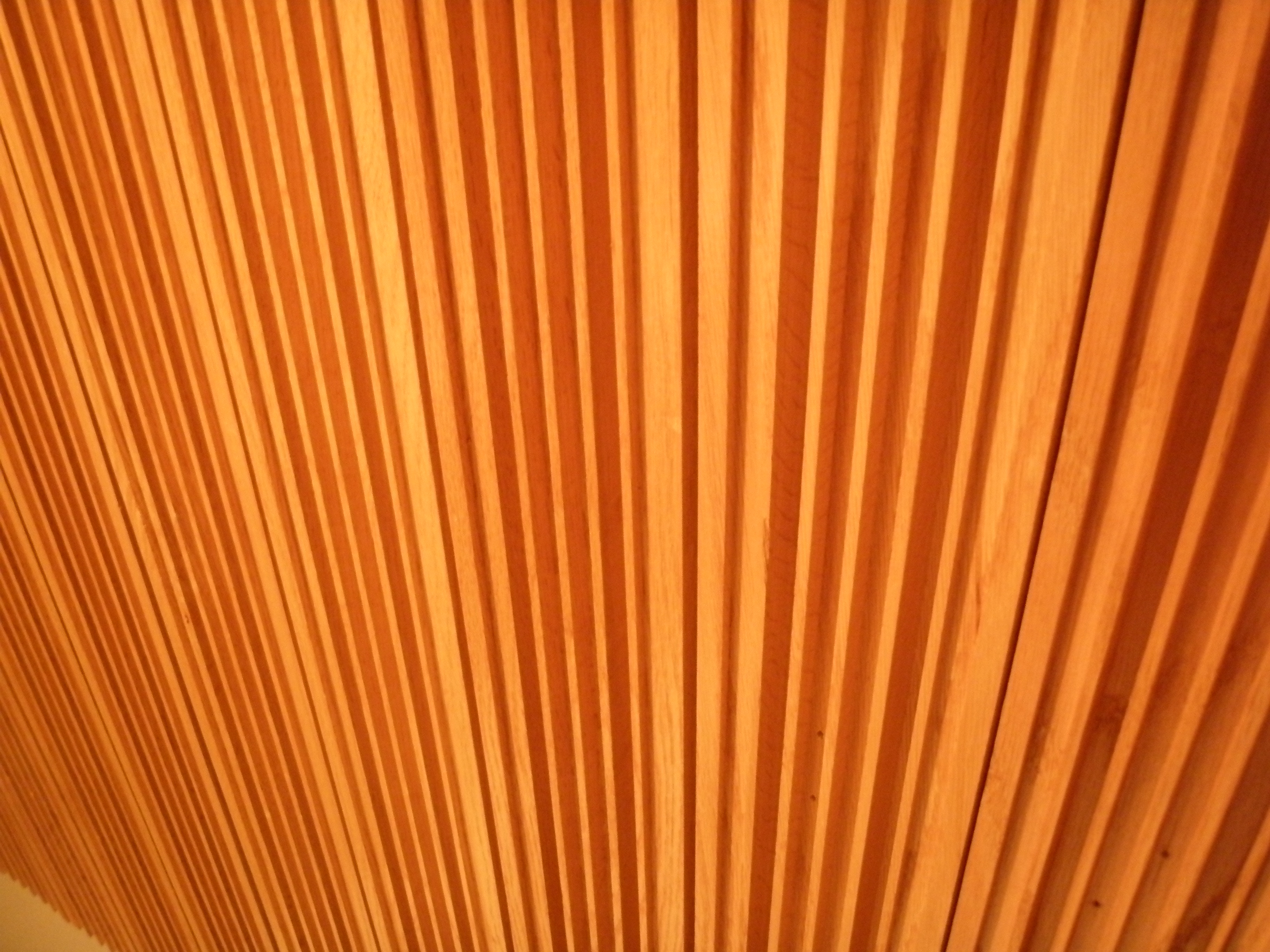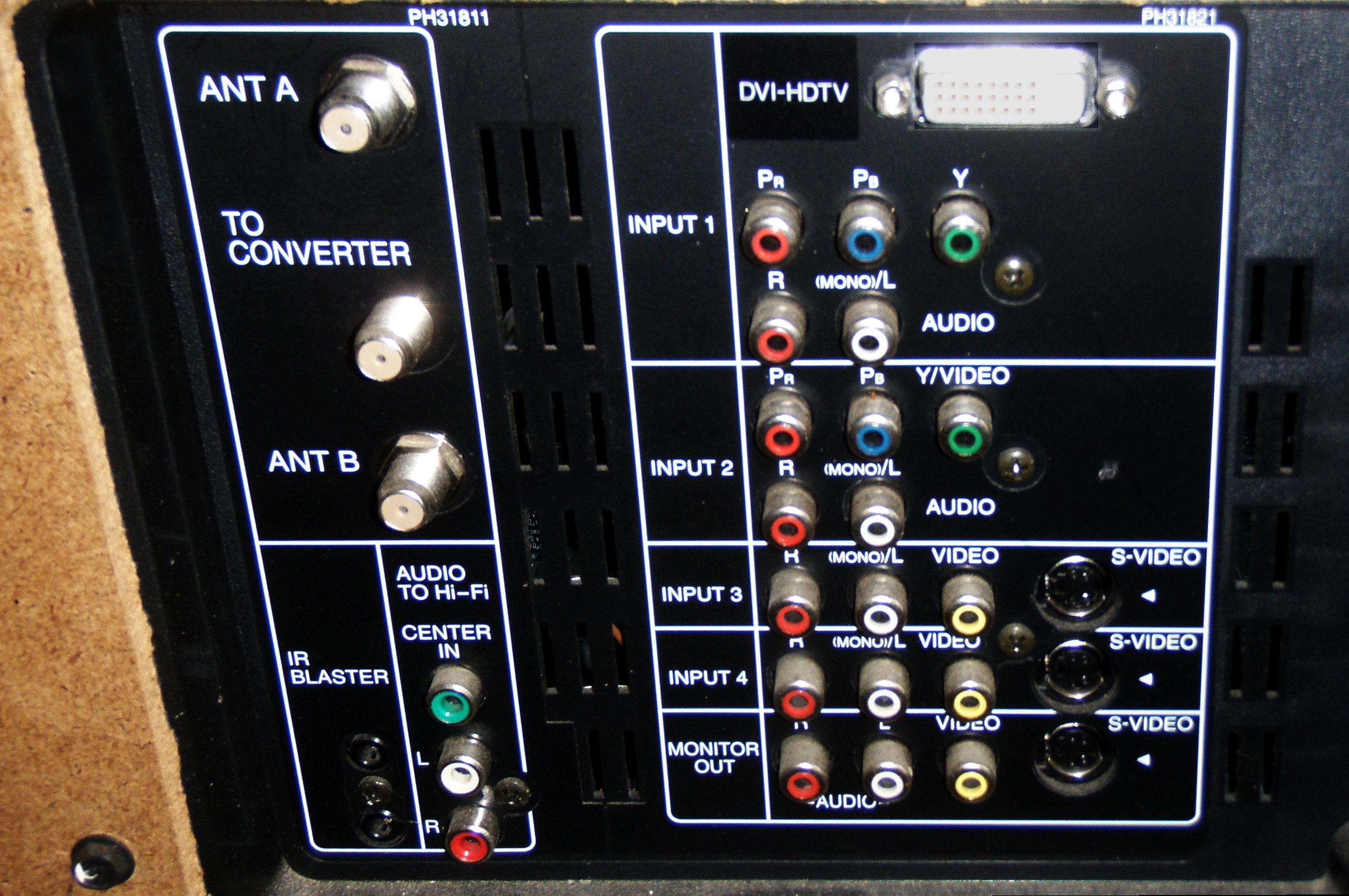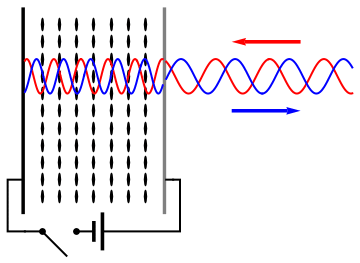|
Light Valve
A light valve (LV) is a device for varying the quantity of light, from a source, which reaches a target. Examples of targets are computer screen surfaces, or a wall screen in the case of a light projector. There are two basic principles of achieving this. One is by deflecting the light on its way to the target (a reflective LV). The other method is to block the light (a transmissive LV). The blocking method has found its way into liquid crystal displays (LCDs), video projectors and rear projection TVs. In this type of screens and projectors, the source light is first polarised by a filter in one direction and then passed on to another filter, filled with liquid crystals. By changing the voltage applied to this crystal filter, it will work as a switching polarising filter, giving different gray scales of the light coming out. The light is changed only once for each image frame. The light valve thus consists of the two polarising filters, where one has a voltage controlled switch ... [...More Info...] [...Related Items...] OR: [Wikipedia] [Google] [Baidu] |
Reflective
Reflection is the change in direction of a wavefront at an interface between two different media so that the wavefront returns into the medium from which it originated. Common examples include the reflection of light, sound and water waves. The ''law of reflection'' says that for specular reflection (for example at a mirror) the angle at which the wave is incident on the surface equals the angle at which it is reflected. In acoustics, reflection causes echoes and is used in sonar. In geology, it is important in the study of seismic waves. Reflection is observed with surface waves in bodies of water. Reflection is observed with many types of electromagnetic wave, besides visible light. Reflection of VHF and higher frequencies is important for radio transmission and for radar. Even hard X-rays and gamma rays can be reflected at shallow angles with special "grazing" mirrors. Reflection of light Reflection of light is either '' specular'' (mirror-like) or ''diffuse'' (retaining t ... [...More Info...] [...Related Items...] OR: [Wikipedia] [Google] [Baidu] |
Transmittance
Electromagnetic radiation can be affected in several ways by the medium in which it propagates. It can be Scattering, scattered, Absorption (electromagnetic radiation), absorbed, and Fresnel equations, reflected and refracted at discontinuities in the medium. This page is an overview of the last 3. The transmittance of a material and any surfaces is its effectiveness in transmitting radiant energy; the fraction of the initial (incident) radiation which propagates to a location of interest (often an observation location). This may be described by the transmission coefficient. Surface Transmittance Hemispherical transmittance Hemispherical transmittance of a surface, denoted ''T'', is defined as :T = \frac, where *Φet is the radiant flux ''transmitted'' by that surface into the hemisphere on the opposite side from the incident radiation; *Φei is the radiant flux received by that surface. Hemispheric transmittance may be calculated as an integral over the directional trans ... [...More Info...] [...Related Items...] OR: [Wikipedia] [Google] [Baidu] |
Liquid Crystal Display
A liquid-crystal display (LCD) is a flat-panel display or other Electro-optic modulator, electronically modulated optical device that uses the light-modulating properties of liquid crystals combined with polarizers to display information. Liquid crystals do not emit light directly but instead use a backlight or Reflector (photography), reflector to produce images in color or Monochrome monitor, monochrome. LCDs are available to display arbitrary images (as in a general-purpose computer display) or fixed images with low information content, which can be displayed or hidden: preset words, digits, and seven-segment displays (as in a digital clock) are all examples of devices with these displays. They use the same basic technology, except that arbitrary images are made from a matrix of small pixels, while other displays have larger elements. LCDs are used in a wide range of applications, including LCD televisions, computer monitors, Dashboard, instrument panels, flight instrument ... [...More Info...] [...Related Items...] OR: [Wikipedia] [Google] [Baidu] |
Video Projectors
Video is an electronic medium for the recording, copying, playback, broadcasting, and display of moving visual media. Video was first developed for mechanical television systems, which were quickly replaced by cathode-ray tube (CRT) systems, which, in turn, were replaced by flat-panel displays of several types. Video systems vary in display resolution, aspect ratio, refresh rate, color capabilities, and other qualities. Analog and digital variants exist and can be carried on a variety of media, including radio broadcasts, magnetic tape, optical discs, computer files, and network streaming. Etymology The word ''video'' comes from the Latin verb ''video,'' meaning to see or ''videre''. And as a noun, "that which is displayed on a (television) screen," History Analog video Video developed from facsimile systems developed in the mid-19th century. Early mechanical video scanners, such as the Nipkow disk, were patented as early as 1884, however, it took several decades b ... [...More Info...] [...Related Items...] OR: [Wikipedia] [Google] [Baidu] |
Rear-projection Television
Rear-projection television (RPTV) is a type of large-screen television display technology. Until approximately 2006, most of the relatively affordable consumer large screen TVs up to used rear-projection technology. A variation is a video projector, using similar technology, which projects onto a screen. Three types of projection systems are used in projection TVs. CRT rear-projection TVs were the earliest, and while they were the first to exceed 40", they were also bulky and the picture was unclear at close range. Newer technologies include DLP (reflective micromirror chip), LCD projectors, Laser TV and LCoS. They are capable of displaying high-definition video up to 1080p resolution, and examples include Sony's SXRD (Silicon X-tal Reflective Display), JVC's D-ILA (Digital Direct Drive Image Light Amplifier) and MicroDisplay Corporation's Liquid Fidelity. Background and history Necessity Cathode ray tube technology was very limited in the early days of television. It ... [...More Info...] [...Related Items...] OR: [Wikipedia] [Google] [Baidu] |
Polarization (waves)
, or , is a property of transverse waves which specifies the geometrical orientation of the oscillations. In a transverse wave, the direction of the oscillation is perpendicular to the direction of motion of the wave. One example of a polarized transverse wave is vibrations traveling along a taut string, for example, in a musical instrument like a guitar string. Depending on how the string is plucked, the vibrations can be in a vertical direction, horizontal direction, or at any angle perpendicular to the string. In contrast, in longitudinal waves, such as sound waves in a liquid or gas, the displacement of the particles in the oscillation is always in the direction of propagation, so these waves do not exhibit polarization. Transverse waves that exhibit polarization include electromagnetic waves such as light and radio waves, gravitational waves, and transverse sound waves ( shear waves) in solids. An electromagnetic wave such as light consists of a coupled oscillating el ... [...More Info...] [...Related Items...] OR: [Wikipedia] [Google] [Baidu] |
Digital Micromirror Device
The digital micromirror device, or DMD, is the microoptoelectromechanical system (MOEMS) that is the core of the trademarked Digital Light Processing (DLP) projection technology from Texas Instruments (TI). The device is used in digital projectors and consists of an array of millions of microscopic mirrors which can be individually tilted many thousand times per second, thereby creating the pixels of the projected images. History The technology goes back to 1973 with Harvey C. Nathanson's (inventor of MEMS c. 1965) use of millions of microscopically small moving mirrors to create a video display of the type now found in digital projectors. The project at Texas Instrument's began as the deformable mirror device in 1977 using micromechanical analog light modulators. The DMD was invented by solid-state physicist and TI Fellow Emeritus Dr. Larry Hornbeck in 1987. The first analog DMD product was the TI DMD2000 airline ticket printer that went to market in 1990 and used a DM ... [...More Info...] [...Related Items...] OR: [Wikipedia] [Google] [Baidu] |
Eidophor
An Eidophor was a video projector developed in the 1940s, used to create theater-sized images from an analog video signal. The name Eidophor is derived from the Greek word-roots ''eido'' and ''phor'' meaning 'image' and 'bearer' (carrier). Its basic technology was the use of electrostatic charges to deform an oil surface. Origins and use The idea for the original Eidophor was conceived in 1939 in Zürich by Swiss physicist Fritz Fischer, professor at the ''Labor für technische Physik'' of the Swiss Federal Institute of Technology, with the first prototype being unveiled in 1943. A basic patent was filed on November 8, 1939, in SwitzerlandMonika Burri''Der Eidophor-Projektor.''ETH History 1855 - 2005. Retrieved 26 September 2019 and granted by the United States Patent and Trademark Office (patent no. 2,391,451) to Friederich Ernst Fischer for the ''Process and appliance for projecting television pictures'' on 25 December 1945. During the Second World War, Edgar Gretener wo ... [...More Info...] [...Related Items...] OR: [Wikipedia] [Google] [Baidu] |
Grating Light Valve
The grating light valve (GLV) is a "micro projection" technology that operates using a dynamically adjustable diffraction grating. It competes with other light valve technologies such as Digital Light Processing (DLP) and liquid crystal on silicon (LCoS) for implementation in video projector devices such as rear-projection televisions. The use of microelectromechanical systems (MEMS) in optical applications, which is known as optical MEMS or micro-opto-electro-mechanical structures (MOEMS), has enabled the possibility to combine the mechanical, electrical, and optical components in tiny-scale. Silicon Light Machines (SLM), in Sunnyvale CA, markets and licenses GLV technology with the capitalised trademarks "'Grated Light Valve'" and GLV, previously Grating Light Valve. The valve diffracts laser light using an array of tiny movable ribbons mounted on a silicon base. The GLV uses six ribbons as each pixel's diffraction gratings. Electronic signals alter the alignment of the gratin ... [...More Info...] [...Related Items...] OR: [Wikipedia] [Google] [Baidu] |
Femtosecond Pulse Shaping
In optics, femtosecond pulse shaping refers to manipulations with temporal profile of an ultrashort laser pulse. Pulse shaping can be used to shorten/elongate the duration of optical pulse, or to generate complex pulses. Introduction Generation of sequences of ultrashort optical pulses is key in realizing ultra high speed optical networks, Optical Code Division Multiple Access (OCDMA) systems, chemical and biological reaction triggering and monitoring etc. Based on the requirement, pulse shapers may be designed to stretch, compress or produce a train of pulses from a single input pulse. The ability to produce trains of pulses with femtosecond or picosecond separation implies transmission of optical information at very high speeds. In ultrafast laser science pulse shapers are often used as a complement to pulse compressors in order to fine-tune high-order dispersion compensation and achieve transform-limited few-cycle optical pulses. Techniques A pulse shaper may be visual ... [...More Info...] [...Related Items...] OR: [Wikipedia] [Google] [Baidu] |
MIIPS
Multiphoton intrapulse interference phase scan (MIIPS) is a method used in ultrashort laser technology that simultaneously measures (phase characterization), and compensates (phase correction) femtosecond laser pulses using an adaptive pulse shaper. When an ultrashort laser pulse reaches a duration of less than a few hundred femtosecond, it becomes critical to characterize its duration, its temporal intensity curve, or its electric field as a function of time. Classical photodetectors measuring the intensity of light are still too slow to allow for a direct measurement, even with the fastest photodiodes or streak cameras. Other means have been developed based on quasi instantaneous non linear optical effects such as autocorrelation, FROG, SPIDER, etc. However, these can only measure the pulse characteristics but not correct for defects in order to make the pulse as short as possible. For instance, the pulse could be linearly chirped or present higher order group delay dispersion ... [...More Info...] [...Related Items...] OR: [Wikipedia] [Google] [Baidu] |
Spatial Light Modulator
A spatial light modulator (SLM) is a device that can control the intensity, phase, or polarization of light in a spatially varying manner. A simple example is an overhead projector transparency. Usually when the term SLM is used, it means that the transparency can be controlled by a computer. SLMs are primarily marketed for image projection, displays devices, and maskless lithography. SLMs are also used in optical computing and holographic optical tweezers. Usually, an SLM modulates the intensity of the light beam. However, it is also possible to produce devices that modulate the phase of the beam or both the intensity and the phase simultaneously. It is also possible to produce devices that modulate the polarization of the beam, and modulate the polarization, phase, and intensity simultaneously. SLMs are used extensively in holographic data storage setups to encode information into a laser beam similarly to the way a transparency does for an overhead projector. They can ... [...More Info...] [...Related Items...] OR: [Wikipedia] [Google] [Baidu] |








